Talgarth is a town situated in the historic county of Breconshire, about 12 miles north of Crickhowell, 19 miles north-east of Brecon and 15 miles south-east of Builth Wells. The town was reputedly the capital of the early medieval Welsh Kingdom of Brycheiniog. The men of Talgarth who fell during both World Wars are commemorated on a bronze memorial plaque, which is situated near to the centre of the town and by the river. I have taken the liberty of adding the details of several men below who are omitted from the memorial.
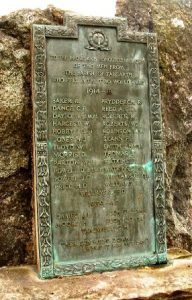
The Great War, 1914-1918
Richard Baker, MM, Lance Corporal, 39687, South Wales Borderers. Richard was born at Presteigne in 1891, the son of William Baker and Jane Baker (nee Meredith). He left home and was working for Richard Price, of Newbuilding, Llandilo Graban, Erwood by 1911, but had moved to Talgarth prior to the war. Richard enlisted into the Welsh Regiment at Newport, Monmouthshire in the spring of 1916. After completing his training, he was drafted to France, where he was posted to the 10th Battalion, South Wales Borderers, which was attached to 115 Brigade, 38th (Welsh) Division. He probably joined the battalion after it had taken part in the divisions famous assault on Mametz Wood in July 1916. It then took over a section of the front at Hébuterne before moving to the Ypres Salient and taking over the Canal Bank sector at Boesinghe. The infantry battalions of the Division then began carrying out the normal pattern of rotation in the trenches, four days in the front, four in support and four in reserve, whilst also working on trench improvement, digging new trenches, and carrying out regular patrols and trench raids. On 31 July 1917 the Division launched its famous assault on the Pilckem Ridge, capturing Iron Cross and reaching its objective of the Steenbeek, then played a supporting role in the Battle of Langemarck. Richard gained the award of the Military Medal for his bravery at Ypres, whilst acting as a battalion machine-gunner. All of his gun crew were wounded, yet he remained at his post firing his gun for four hours until his wounded comrades could be rescued. Richard came home on leave shortly after and by the time he returned to the front, the division had been transferred to the Sailly-sur-la-Lys sector. During the early hours of 8 November 1917, the 10th SWB carried out a trench raid upon the Germans in the L’Epinette sector. Although the raid was successful, seven men of the battalion were killed and a further 48 wounded. Richard was among those wounded. He was carried back to the lines by his comrades but died of his wounds that same day. The 26-year-old was buried in Erquinghem-Lys Churchyard Extension, France.
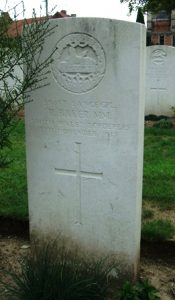
Charles Philip Dance, Private, 107, Australian Light Trench Mortar Battery. Charles was born in Callow, Herefordshire in 1897, the son of Peter Dance and Emma Dance (nee Hatton). The family later moved to 3, Church Road, Talgarth, but Charles left home and emigrated to Australia in the summer of 1911, where he found work as a milk carrier. Charles enlisted at Melbourne into the Australian Imperial Force on 5 February 1915 and was posted to A Company, 23rd Battalion, Australian Infantry. The battalion was raised in Victoria in March 1915, joining the 6th Brigade, 2nd Australian Division and in March embarked for Egypt, where it completed its training before landing at Anzac Cove, Gallipoli in early September. Charles was wounded in the back soon afterwards and was evacuated aboard HMHS Glenart Castle to hospital in Alexandria. By the time he re-joined his battalion it had been evacuated from Gallipoli to Egypt. The 2nd Division embarked for France on 19 March 1916 and after disembarking at Marseilles entrained for Flanders, taking over positions in the Nursery Sector near Armentieres. The Australians moved to the Somme in July and took part in the horrific fighting for Pozieres and Mouquet Farm, suffering terrible casualties. The Australians then wintered in the Somme sector before following the German withdrawal to the Hindenburg Line in March 1917 and saw further heavy fighting during the Battle of Bullecourt in May. On 19 July 1917 Richard was transferred to the 6th Australian Light Trench Mortar Battery, in the same 2nd Division. Later in 1917 the division moved with the rest of the AIF to the Ypres sector, and in October saw heavy fighting on Broodeseinde Ridge. The Australians then took part in the desperate fighting which followed the German offensive on the Lys in April 1918 before moving south to the Somme valley and on 8 August 1918 took part in an epic action during the Battle of Villers-Bretonneux, which saw the Germans defeated and the war turn. Charles was killed in action here on 11 August 1918. The 21-year-old was buried in Heath Cemetery, Harbonnières, France.
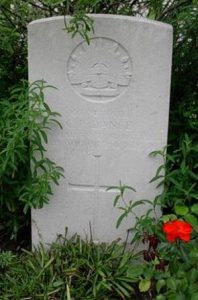
Percy Frederick Davies, Staff Sergeant, 7246818, Royal Army Medical Corps. Percy was born in Hereford on 4 April 1890, the son of Percival John Davies and Rosetta Davies (nee Grainger). He was already serving in the army, with the Royal Army Medical Corps, when war erupted and embarked for France with the BEF on 20 August 1914, being posted to the 1st General Hospital. Percy served on the Western Front for the entire war, being promoted to Staff Sergeant by the time of the Armistice. He went to live at Talgarth after being demobilised and married Edith Elizabeth Hughes, of High Street, Talgarth, on 6 September 1920. Percy had by now re-enlisted into the army and soon after his marriage was posted to Southern Ireland, as part of a large British military force sent there to attempt to keep the peace against an ever-growing IRA threat. Percy took ill soon after arriving in Ireland and died of tuberculosis in Limerick Military Hospital on 4 May 1921. The remains of the 31-year-old were conveyed back home, and he was buried six days later in St. Gwendolen’s Churchyard, Talgarth. Percy is not commemorated on the Talgarth war memorial.
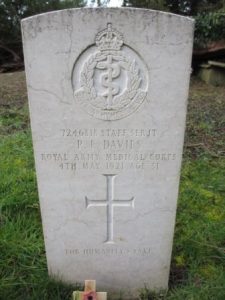
Owen Samuel Day, MM, Sergeant, 7953, Cheshire Regiment. Owen was born on 21 October 1882, the son of Henry Charles Day and Henrietta Day (nee Bond), of 28, Osborne Street, Newton Abbott. He had left home as a young man to enlist into the army and had served with the 1st Battalion, Devonshire Regiment during the Anglo-Boer War of 1899-1902, taking part in the fighting at Belfast and Natal. By 1911 he was living with his sister Alice at 52 Penge Road, South Norwood, where he was a shopkeeper. On 9 April 1911 Owen married Edith Elizabeth Palmer. The couple then moved to Cardiff for a short while, before Owen gained a position as a postman at Talgarth, and the couple moved there to 4, New Street. Owen re-joined the army following the outbreak of war and joined the 1st Battalion, Cheshire Regiment. The battalion was attached to 15 Brigade, 5th Division and landed in France on 16 August 1914, before entraining for the frontier town of Mons to join the BEF. The division then took part in the Battle of Mons, following the German assault on 23 August and took part in the subsequent retreat from Mons to the Marne, where the German drive on Paris was stopped. It then took part in the advance to the Aisne, before moving to Flanders, where it fought at the Battle of La Bassée, then at Messines in October 1914. The division fought here through the First Battle of Ypres, and took part in the capture of Hill 60, and then fought at Second Ypres in April 1915. Owen was badly wounded during Second Ypres and after lengthy treatment in hospital in France was invalided back to Britain. He did not return to France until early in 1917 when he was posted to the 16th Battalion, Cheshire Regiment, which was attached to 105 Brigade, 35th Division. The Division followed the German Retreat to the Hindenburg Line in March 1917, then took up positions facing the Hindenburg Line, near Épehy. On 6 September 1917 Owen’s battalion relieved the 14th Gloucester’s in the front line near Guillemont Farm to begin a routine tour in the trenches. During the early hours of 9 September 1917 Owen went out with a trench raiding party. The party failed to find a way through the wire and was forced to withdraw. As soon as the party reached its own lines, the Germans opened up an artillery barrage upon them, and Owen and seven other men were killed when a direct hit blew in their trench. Owen was 43 years old when he was killed that day. He has no known grave, so is commemorated on the Thiepval Memorial, France. He had been awarded the Military Medal during his second period on the Western Front, for carrying in a wounded comrade whilst under heavy fire.
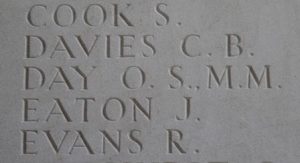
Samuel Fisher, Private, DM2/171564, Royal Army Service Corps. Samuel was born at Pontycymmer in 1886, the son of Noah Fisher and Elizabeth Fisher (nee Morgan). Samuel worked as a collier in the Garw Valley for many years. He married Elizabeth Richards at Neath on 13 October 1906 and the couple lodged at 1, Tip Terrace, Tonmawr, where their two children were born, then Elizabeth sadly died in 1912. Samuel enlisted at Cardiff into the South Wales Borderers on 12 August 1914, but on 5 November he deserted from the regiment. He then re-enlisted at Woolwich into the Royal Garrison Artillery on 28 November 1914 and married Mary Ann Evans whilst on leave on 22 May 1915. Samuel was discharged from the Royal Garrison Artillery as medically unfit two months later, but then re-enlisted again into the Army Service Corps, serving for the duration of the war. He was discharged from the army on 4 June 1920 after having been found to have contracted tuberculosis and returned to his wife at Louisiana, Talgarth. Samuel eventually died of tuberculosis at Talgarth on 26 August 1923. The 37-year-old was buried in St. Gwendolen’s Churchyard, Talgarth. Samuel is not commemorated by the CWGC and is not commemorated on the Talgarth war memorial.
John Edward Gately, Lieutenant, Indian Army Reserve of Officers. John was born at Talgarth in 1887, the son of Bernard Gately and Leonara Gately (nee O’Leary). His father, an Irishman, was an Excise Officer at Talgarth for many years prior to moving his family to Liverpool by 1901. John had been educated at Talgarth and then at Brecon County School, then when the family moved to Liverpool, he entered St. Francis Xavier’s College before studying at the University of Liverpool. After leaving the university he went to India after being appointed Professor of Economics at Agra, and later took up a similar role at the Government College, Lahore. At the outbreak of war was commissioned as Second Lieutenant into the Indian Army and went to France with the Bengal Lancers. As the cavalry had little real involvement with any fighting during much of the war, John sought a transfer to the Machine Gun Corps, joining one of the companies in the 16th (Irish) Division. The division was south of Ypres when John arrived, and on 7 June 1917 took part in the Battle of Messines Ridge, which was heralded by the blowing of a series of vast underground mines beneath key German positions. John was wounded on the opening day of the battle and was eventually evacuated back to England, before being sent to the Fourth London General Hospital, at Denmark Hill. He died of his wounds there on 13 June 1917. The remains of the 30-year-old were brought back to Liverpool, and he was buried in Ford Roman Catholic Cemetery, Liverpool on 19 June. John is not commemorated on the Talgarth war memorial. One of his brothers, Ambrose, was reported as having been killed in 1916, but actually survived the war.
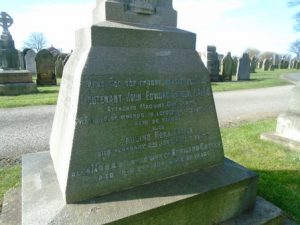
Harold John Gibble, Lance Corporal, A/201705, King’s Royal Rifle Corps. Harold was born in 1898, the son of Thomas Gibble and Minnie Gibble (nee Freebury), of Highcliff, Talgarth. His mother died in 1901 and his father remarried to Harriet Agnes Morgan on 20 September 1902, before the family moved to Elms Cottage, 11, The Struet, Brecon by 1911. After leaving school, Harold found work at the printing works of the Brecon and Radnor Express. He enlisted into the King’s Royal Rifle Corps at Canning Town, London soon after the outbreak of war. Upon completing his training, Harold was drafted to France, joining the 10th Battalion, King’s Royal Rifle Corps, which was attached to 59 Brigade, 20th (Light) Division. Harold probably joined the battalion in France after the 20th Division had taken part in the terrible fighting for Mount Sorrel in June 1916. The division then moved south and fought through the Somme Offensive, at the Battles of Delville Wood, Guillemont, Flers-Courcelette, Morval and Le Transloy, before wintering on the Somme and took part in the advance to the Hindenburg Line in March 1917. Later that year the division moved to the Ypres Salient, taking over positions in support of the 38th (Welsh) Division for their opening assault on Pilckem Ridge on 31 July 1917. The 10th KRRC, based at Canada Farm, was put to work clearing debris on the local roads and tracks as the battle raged in front of them, then on 7 August moved into the old front-line positions on the Canal Bank, before relieving the battered 38th Division. On 11 August the 10th KRRC took part in an attack against the German lines on the Steenbeek in front of Langemarck, suffering heavy casualties whilst attempting to attack through thick mud. Harold was among 85 men posted as missing during the attack that day. He was later found to have been wounded and taken prisoner by the Germans and died of his wounds in a German Hospital at Harlebeke on 14 August 1917. The 18-year-old is buried in Harlebeke New British Cemetery, Belgium. Harold is commemorated at Brecon, but not on the Talgarth war memorial.
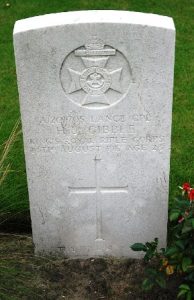
William Hargest, Private, 15904, Duke of Cornwall’s Light Infantry. William was born in 1868, the son of John Hargest and Ann Hargest (nee Jones), of Church Street, Talgarth. He left home as a young man and in 1892 enlisted into the Duke of Cornwall’s Light Infantry. William served in the army for several years, including on the North-West Frontier. By 1911 was living back at Glanyrafon, Talgarth, with a younger sister, Mary Ann, and was working as a farm labourer, but soon afterwards left to work as a collier. As an army reservist, he re-enlisted into his old regiment at Ferndale as soon as war broke out and after a time at home with the 3rd Battalion, was posted to France on 26 January 1915, joining the 2nd Battalion, Duke of Cornwall’s Light Infantry, which was at Dickebusch, in the Ypres Salient, attached to 82 Brigade, 27th Division. The division saw its first major action during the Second Battle of Ypres, which was opened following a German poison gas attack at Gravenstafel on 22 April 1915 and lasted until 25 May 1915. The 27th Division was heavily involved in the terrible fighting for the city during that time and suffered severe casualties. William was wounded at Ypres and returned home on leave in the summer after recovering from his wounds. He then returned to the 3rd Battalion, Duke of Cornwall’s Light Infantry, which by then was stationed at Freshwater, on the Isle of Wight, to prepare for his return to action. William was not to see action again though, as he died at Parkhurst Military Hospital on 15 December 1915. The 44-year-old was buried in Parkhurst Military Cemetery, Isle of Wight.
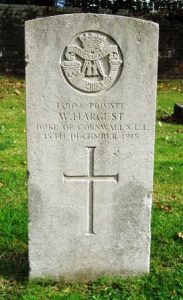
John Henry Hobby, Sergeant, 10368, South Wales Borderers. John was born on 11 December 1885, the son of John Hobby and Mary Ann Hobby (nee Hargest), of Upper House, Bronllys. John left home as a young man to work at Castle Farm, Boughrood. By now his family had moved to Station Yard, Talgarth. John then enlisted at Brecon into the South Wales Borderers. He was in China serving with the 2nd Battalion, South Wales Borderers when war broke out. The battalion took part in a famous operation with the Japanese against the German held port of Tsingtao on 23 September. On 4 December the battalion embarked at Hong Kong and landed at Plymouth on 12 January 1915, entraining for Rugby to join 87 Brigade, 29th Division. On 17 March 1915 the battalion sailed from Avonmouth with the Division, arriving at Alexandria on 29 March, before moving to Mudros. On 25 April 1915 the Division landed at Cape Helles, Gallipoli, as part of the original landing force which had been despatched to try and seize the Dardanelles Straits and force Turkey out of the war. The invasion forces failed to break the Turkish defences and the campaign became bogged down, so after an arduous eight months on the Peninsula the 29th Division was evacuated to Egypt on 11 January 1916, before being transferred to the Western Front, landing at Marseilles on 15 March and entraining for the Somme sector, taking up positions near Beaumont Hamel, facing Y-Ravine. The Division had an arduous time here too over the coming months, before taking part in a suicidal assault on 1 July 1916, on the opening day of the Somme offensive. The 2nd SWB alone suffered some 384 casualties on that day alone. Although severely depleted, the Division remained in the line here over the coming weeks, in trying conditions. The Division was then pulled out of the line to rest and rebuild before moving back into the line and taking part in the latter stages of the Somme offensive. The Division wintered on the Somme, taking part in the advance which followed the German withdrawal to the Hindenburg Line. At the beginning of April, the entire 29th Division moved out of the Somme sector to the Arras sector, and by 9 April took over a section of the line facing Monchy-le-Preux. The Division then began to prepare for the forthcoming Battle of Arras. At dawn on 23 April 1917, the Division launched an assault on Monchy-le-Preux. The 2nd SWB captured the front-line German trench and advanced some 300 yards beyond before consolidating its gains. John was killed in action at some time during the day. The 31-year-old is buried in Tilloy British Cemetery, Tilloy-Les-Mofflaines, France.
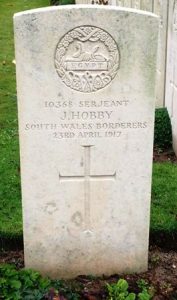
George Hobday Hopper, Leading Stoker, K/1099, Royal Navy. George was born at Talgarth on 9 May 1888, the son of George and Annie Hopper. By 1891 the family had moved to 6, Station View, Llanidloes. George worked as a lead miner prior to enlisting into the Royal Navy on 6 August 1908, signing up for twelve years. He was posted to Chatham for training before being posted aboard HMS Acheron on 6 August 1908. On 2 February 1909 he was transferred aboard HMS Implacable, then transferred between HMS Cyclops and HMS Pembroke II over the coming years. On 7 March 1916 George was posted aboard the newly launched Arabis-class minesweeping sloop, HMS Mignonette. Mignonette joined the Tenth Sloop Flotilla upon her completion in March 1916 and operated with them off the Irish Coast. Mignonette was at sea on 17 March 1917 when she struck a German laid mine off the coast of Ireland and sank. George was among fourteen men killed during her sinking. The 28-year-old is commemorated on the Chatham Naval Memorial, Kent. His youngest brother, Albert, died as a PoW in Germany in 1918. George is not commemorated on the Talgarth war memorial.
Alfred Inseal, Private, 19931, South Wales Borderers. Alfred was born in 1885, the son of Alfred Inseal and Emily Inseal (nee Rogers), of Pelton, Herefordshire. He married Sarah Vaughan, of Talgarth, on 17 November 1909 and the couple lived at Holly Bush Cottage, Llangorse. Alfred worked as a railway platelayer for many years prior to the war. He enlisted into the South Wales Borderers at Brecon on 31 May 1915 and was posted to the 3rd Battalion, South Wales Borderers, which was at Hightown, near Liverpool, on garrison duties. Alfred began to suffer from ill-health soon after his arrival at Liverpool and was discharged from the army as medically unfit on 9 August 1915 and returned to his family at Llangorse. His health continued to wane, and Alfred died at the Brecon and Radnor Asylum, Talgarth on 2 October 1917. The 32-year-old was buried in St. Gwendolen’s Churchyard, Talgarth four days later. He is not commemorated on the Talgarth war memorial.
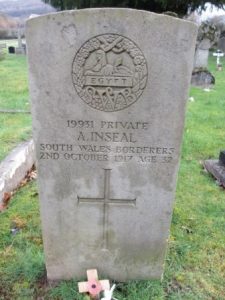
Henry John Jones, Private, 32162, Northumberland Fusiliers. Henry was born on 1 August 1884, the son of John Jones and Mary Ann jones (nee Prosser), of Ponthill, Three Cocks, Brecon. His father was from Talgarth, and later moved back to 1, The Terrace, Trefecca. Henry was educated at Glastonbury, before becoming an Infirmary Nurse at the Tynemouth Poor Law Institution in North Shields. He married Mabel Keturah Millyard, of 11, Station Road, Crawley on 2 June 1909, and the couple had one child, a son Leslie, born in 1912. Henry enlisted into the Northumberland Fusiliers at North Shields on 20 June 1916 and was drafted to France on 8 December 1916, joining the 21st (Tyneside Scottish) Battalion, Northumberland Fusiliers, which was attached to 102 Brigade, 34th Division. Henry joined the battalion at Bois Grenier and on 23 December saw his first taste of trench life when his new battalion moved into the front line to begin a routine tour in the line over Christmas. Henry was wounded whilst in the trenches on 12 January 1917 and was evacuated to hospital at Bailleul, where he died of his wounds on the following day, 13 January 1917. The 32-year-old was buried in Bailleul Communal Cemetery Extension, France.
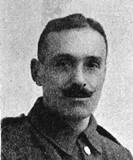
Percy Jones, Master Sergeant Cook, 212, South Wales Borderers. Percy was born on 2 March 1880, the son of Richard Jones and Sarah Jones (nee Williams), of 47, Free Street, Brecon. He married Elizabeth Sims at Builth on 4 February 1903 and the couple initially set up home at 11, Oaklands, Builth Wells, before moving to 5, New Street, Talgarth by 1909. Percy worked as a painter at the Asylum prior to the war. Percy enlisted into the Brecknockshire Battalion, South Wales Borderers on 7 April 1908 and became a well-known man in the battalion during the pre-war years, becoming the battalions cook, and took part in every annual TA summer camp up until the outbreak of war. He was mobilised on 5 August 1914, joining the 2/1st Brecknock Battalion, South Wales Borderers. The battalion then left Brecon for Dale, in Pembrokeshire to join the Milford Haven garrison. Soon afterwards Percy began suffering with his health and was discharged from the army as medically unfit on 27 February 1915. He returned to Talgarth to his family, but his health continued to fail over the coming years, and he died of diabetes on 18 January 1918. The 37-year-old was buried in St. Gwendolen’s Churchyard, Talgarth five days later. He is not commemorated on the Talgarth war memorial.
Albert Lewis, Private, 27782, South Wales Borderers. Albert was born in 1897, the son of James Lewis and Emily Lewis (nee Parry), of Maund Brian, Bodenham, Hereford. He left home as a young man and by 1911 was lodging at Marden Court, near Hereford, where he was working as a farm hand. He was working for Joshua Mills, J.P., at Tyrbryn, Talgarth when war broke out. Albert enlisted into the Brecknockshire Battalion, South Wales Borderers at Talgarth soon after the outbreak of war. The battalion was attached to the Welsh Division and moved to Pembroke Dock upon mobilisation. It was then withdrawn from the Division and on 29 October 1914 sailed from Southampton for Bombay, where the battalion transhipped and sailed for Aden, arriving on 16 December 1914. The battalion endured a torrid time in the heat of Aden, losing several men to heatstroke. Albert joined the battalion as part of a draft of reinforcements which disembarked at Aden on 3 July 1915, on a day which saw the battalion lose a number of men through heatstroke. In August 1915 the battalion moved to India on garrison duties. Albert then volunteered to transfer to the Devonshire Regiment, so that he could see action in Mesopotamia. Upon his arrival he transferred to the 4th Battalion, South Wales Borderers. The battalion, attached to 40 Brigade, 13th (Western) Division, had been there since March 1916, following service in Gallipoli and Egypt, and upon its arrival had taken part in the attempts to relieve General Townshend’s besieged force at Kut-al-Amara. Albert was killed in action in Mesopotamia on 30 May 1917, during the advance from Baghdad. The 19-year-old has no known grave and is commemorated on the Basra Memorial, Iraq. Albert is not commemorated on the Talgarth war memorial. A brother, Hamer Lewis, was killed in France in 1918, whilst a nephew, James Edgar Lewis, was killed with the RAF during WW2.
John Lewis, Private, 2940, Welsh Regiment. John was born at Swansea in 1868. He had enlisted into the army as a young soldier and had fought during the Anglo Boer War in South Africa and upon his return and lived with his wife, Mary Jane Lewis, at 8, Pant Street, Danygraig. He re-enlisted into the 6th Battalion, Welsh Regiment soon after the outbreak of war. The front-line battalion, the 1/6th Welsh, embarked for France on 29 October, but John remained in Britain, with the 2/6th Welsh, probably due to his age. He took ill whilst serving with the battalion on home defence duties and was invalided to Talgarth Asylum, where he died on 20 October 1915. The 47-year-old was buried in Talgarth Hospital Cemetery, with full military honours. He is not commemorated on the Talgarth war memorial.
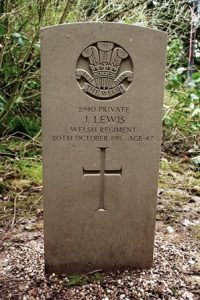
William Lloyd, Private, 1319, South Wales Borderers. William was born at Wrexham in around 1892. By 1911 he was lodging at Llanspyddid House, Brecon, where he worked as a farm labourer, for Edwin Smith. He then found work as an attendant at the Talgarth Asylum. William was already a serving Territorial Army soldier with the Royal Welsh Fusiliers prior to the war, but enlisted at Brecon into the Brecknockshire Battalion, South Wales Borderers in August 1914. The battalion was attached to the Welsh Division and moved to Pembroke Dock upon mobilisation. It was then withdrawn from the Division and on 29 October 1914 sailed from Southampton for Bombay, where the battalion transhipped and sailed for Aden, arriving on 16 December 1914. The climate in Aden was fearsome, with scorching heat during the day, and with little to do, the men spent much of their free time playing football. By June 1915 the Turks had become overconfident due to the lack of any incursions by the British into Yemen and moved forward to reoccupy fortifications at Sheikh Saad. They then began to shell the island of Perim, so the Allied troops in Aden were mobilised into the Aden Movable Company and ordered to prepare to join with local troops. 400 men of the Brecknocks were allocated to the column, the remainder stayed in Aden. A small artillery column was built up to join it and on 3 July the force moved out to Sheikh Othman. Many men collapsed on the march, which was carried out during the full heat of the day, but by 7.30 pm the column had completed its six-mile advance. William was among thirteen men who died of heatstroke during the following day, 4 July 1915, during an even longer march. The 23-year-old is buried in Maala Cemetery, Yemen.
Austin Martin, Private, 14897, South Wales Borderers. Austin was born on 12 February 1875, the son of Charles Martin and Elizabeth Martin (nee Evans), of Prince of Wales Cottage, Talgarth. His parents both died when he was very young, so Austin was sent to the New Mullers Orphanage in Bristol. Upon leaving there he enlisted into the army and served for several years before returning to Wales. He was lodging at 13, Edwards Terrace, Pentywyn by 1911, where he had found work as a collier. Austin began a relationship with a young woman whilst there, and in 1915 their illegitimate son was born. He was later raised by Austin’s brother, James Martin at 6, Webster Street, Treharris. Austin re-enlisted into the army following the outbreak of war, joining the South Wales Borderers. He was originally posted to the 1st Battalion, South Wales Borderers, disembarking in France on 13 November 1914, to join the battalion in Flanders, where it was attached to 3 Brigade, 1st Division. He must have been invalided home soon afterwards, and he was then posted to the 2nd Battalion, South Wales Borderers. The battalion had returned from service in China, landing at Plymouth on 12 January 1915, and entrained for Rugby to join 87 Brigade, 29th Division. On 17 March 1915 the battalion sailed from Avonmouth with the Division, arriving at Alexandria on 29 March, before moving to Mudros. On 25 April 1915 the Division landed at Cape Helles, Gallipoli, as part of the original landing force which had been despatched to try and seize the Dardanelles Straits and force Turkey out of the war. The invasion forces failed to break the Turkish defences and the campaign became bogged down into static trench warfare. Austin was killed in action whilst the battalion was holding the old Eski Line, at Gully Ravine, on 16 June 1915. The 40-year-old was buried by his comrades in Pink Farm Cemetery, Helles, Gallipoli. Austin is not commemorated on the Talgarth war memorial.
David John Morris, Private, 18533, Welsh Regiment. David was born in 1879, the son of William Morris and Eliza Morris (nee Jones), of Brook Cottage, Talgarth. He married Margaret Ann Williams on 18 February 1903, and the couple had two children, Catherine, and William, but by 1908 he had deserted his family, who were then placed in Brecon Workhouse. David had returned to his parent’s home in Talgarth, where he worked as a farm labourer. He enlisted into the Welsh Regiment at Bridgend on 20 October 1914 and was posted to the 13th (2nd Rhondda) Battalion, Welsh Regiment. The battalion moved to Rhyl to join 129 Brigade, 43rd (Welsh) Division and began training at Rhyl and Colwyn Bay. On 29 April 1915 the formation became renumbered to 114 Brigade, 38th (Welsh) Division, before moving to Winchester in the summer of 1915 to complete its training. The Division began moving to France on 2 December 1915 and moved to the Nursery Sector near Fleurbaix for trench initiation alongside the Guards Division. Over the coming months the division moved between different sectors in the area, the most notorious being at Cuinchy, before moving back to the Fleurbaix sector. On 26 May 1916 the 13th Welsh moved into the front line in the Fauquissart area to begin a routine tour in the trenches. David was killed in action here during a remarkably quiet day, on 27 May 1916, the sole casualty suffered by the battalion that day. The 38-year-old was buried in Rue-Du-Bacquerot (13th London) Graveyard, Laventie, France.
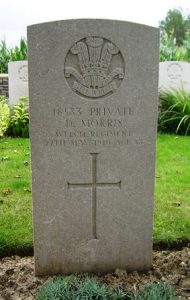
William Benjamin Parton, Private, 701258, Canadian Infantry. William was born on 15 October 1884, the son of Henry Parton and Elizabeth Parton (nee Davies), of Garafog Farm, Pennenfordd, Talgarth. He emigrated to Canada some years prior to the war and settled at Roblin, Manitoba, where he worked as a farmer. William enlisted at Winnipeg into the Canadian Expeditionary Force on 27 March 1916 and was posted to the 101st Overseas Battalion, Canadian Infantry. The battalion embarked for Great Britain aboard the SS Olympic on 29 June 1916, where, on 13 July 1916, its personnel were absorbed by the 17th Reserve Battalion, CEF, to provide reinforcements to the Canadian Corps on the Western Front. William embarked for France on 10 September 1916 and was posted to the 24th Battalion, CEF, which was on the Somme attached to the 5th Brigade, 2nd Canadian Division. William took part in the divisions desperate fighting at the Battle of Flers – Courcelette, which raged from 15–22 September, then saw further fighting with the Canadians throughout the remainder of the Somme offensive. The Canadian Corps moved to positions facing Vimy Ridge over the winter and began to prepare for another offensive, as part of the Battle of Arras. The task facing the Canadians was the capture of Vimy Ridge, a feature which dominates the battlefield north of Arras. Work was already underway, with scores of Royal Engineers and Canadian Engineers tunnelling beneath No Man’s Land, to lay huge underground charges, which would take out the German defences. At dawn on 9 April 1917 the explosives were detonated, and the ground erupted beneath a series of key German positions. The Canadians advanced, launching a frontal assault against the shaken survivors, in terrible conditions. William was posted as missing during the fighting that day and was later deemed to have been killed in action during the assault. The 31-year-old has no known grave and is commemorated on the Vimy Memorial, France.
Charles Baden Powell, Private, 68023, South Wales Borderers. Charles was born in 1900, the son of Charles Powell and Eleanor Powell (nee Prothero), of the Old Vicarage, Talgarth. He enlisted into the army and was posted to the 53rd (Graduated) Battalion, South Wales Borderers. The battalion was one of several which had been set up for training young soldiers. Charles never served overseas. His health declined whilst in training and he was found to have contracted tuberculosis. He returned home to Talgarth, where his condition worsened, so Charles was sent to Beechwood Park Hospital, Newport, Monmouthshire, where he died on 18 February 1921. The remains of the 21-year-old were brought home and he was buried in St. Gwendolen’s Churchyard, Talgarth on 22 February. His parents suffered the loss of another child, Ada, just two months later, whilst another daughter, Daphne, had died of influenza after the Armistice. Charles is not commemorated on the Talgarth war memorial.
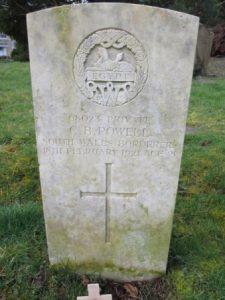
Daphne Elizabeth Powell, Worker, 10897, Queen Mary’s Army Auxiliary Corps. Daphne was born in 1898, the daughter of Charles Powell and Eleanor Powell (nee Prothero), of the Old Vicarage, Talgarth. She enlisted into the Queen Mary’s Army Auxiliary Corps in November 1917 and was posted to Swanage. Daphne served throughout the remainder of the war, before returning home to Talgarth in the spring of 1919. Sadly, she contracted influenza soon after returning home and died on 11 April 1919. The 21-year-old was buried in St. Gwendolen’s Churchyard, Talgarth on 16 April. She lost a brother and a sister to illness within the next two years. Daphne is not commemorated on the Talgarth war memorial.
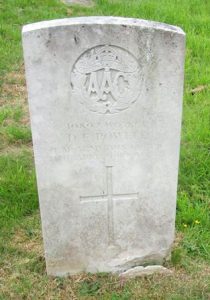
David Bernard Powell, Lieutenant, South Wales Borderers. David was born in 1893, the son of John Jones Powell and Sarah Powell (nee Morgan), of the Tower Hotel, Talgarth. He worked as a clerk for the United Counties Bank at Newport prior to the war. David was commissioned as Second Lieutenant into the Brecknockshire Battalion, South Wales Borderers in January 1916. He was then posted to the 12th Battalion, South Wales Borderers. The battalion was raised at Newport by the Welsh National Executive Committee in March 1915 as a bantam Battalion, then in July 1915 moved to Prees Heath to join the Welsh Bantam Brigade. During September 1915 the Brigade moved to Aldershot and became 119 Brigade, in the 40th (Bantam) Division. In December 1915 the Division moved to Blackdown to complete its training before embarking for France and landing at Le Havre on 2 June 1916. The Division moved to positions around Lillers before taking over the North Maroc Sector, near Loos, for trench initiation and once acclimatised was left to hold the sector itself over the coming months. The infantry battalions of the Division then began the usual routines of rotating for duty in the trenches: normally four days in the front line; four in support and four in reserve. Late in 1916 the Division moved south to the Somme, and fought at the Battle of the Ancre, before remaining in the sector over the winter. In March 1917 the Germans withdrew to their shortened line, called the Hindenburg Line, and the 40th Division was among the units which followed the withdrawal, before settling into new trenches in the Gouzeaucourt sector, facing the Hindenburg Line. On 4 September 1917 David went out into No Man’s Land, leading a small patrol to check the wire defences. He was shot by a sniper and mortally wounded, before his men carried him back to safety. Unfortunately, he died of his wounds that same day. The 24-year-old was buried in Rocquigny-Equancourt Road British Cemetery, Manancourt, France.
John Charles Powell, Private, 12047, South Wales Borderers. John was born in 1879, the son of John and Jane Powell, of Hay, Herefordshire. By 1911 he was lodging at North Street, in Winchcombe, Gloucester, where he was working as a Gents Outfitter. John married Mary Jeanie Ratcliffe, a dressmaker, on 10 January 1914, before the couple went to live at his mothers native Talgarth, setting up home there at Red House. John enlisted into the 3rd Battalion, South Wales Borderers in the spring of 1915. He was then posted to the 12th Battalion, South Wales Borderers. The battalion was raised at Newport by the Welsh National Executive Committee in March 1915 as a bantam Battalion, then in July 1915 moved to Prees Heath to join the Welsh Bantam Brigade. During September 1915 the Brigade moved to Aldershot and became 119 Brigade, in the 40th (Bantam) Division. In December 1915 the Division moved to Blackdown to complete its training before embarking for France and landing at Le Havre on 2 June 1916. The Division moved to positions around Lillers before taking over the North Maroc Sector, near Loos, for trench initiation and once acclimatised was left to hold the sector itself over the coming months. The infantry battalions of the Division then began the usual routines of rotating for duty in the trenches: normally four days in the front line; four in support and four in reserve. Late in 1916 the Division moved south to the Somme, and fought at the Battle of the Ancre, before remaining in the sector over the winter. In March 1917 the Germans withdrew to their shortened line, called the Hindenburg Line, and the 40th Division was among the units which followed the withdrawal. Later in the year the Division took part in the Battle of Cambrai and launched an attack on Bourlon Wood on 23 November 1917. The attack was carried out by 119 Brigade, led by the 12th SWB and 19th RWF. The 17th Welsh was in support for the initial assault, but was soon ordered to advance, to support the two attacking battalions. Heavy fighting raged within the wood over the coming days, with the 18th Welsh also being thrown forwards into the fight, and the Division suffered terribly. John was wounded during the fighting and was evacuated via the usual chain of Advanced Dressing Station to Casualty Clearing Station, before reaching the base hospital at Abbeville. He died there of his wounds on 8 December 1917. The 38-year-old was buried in Abbeville Communal Cemetery Extension, France. His widow, Mary, married a former soldier, Ernest Kirby, at Talgarth in 1922, but sadly she was widowed again the following year.
John Patrick Power, Sapper, WR/100539, Royal Engineers. John was born in 1892, the son of John Power and Bridget Power, of Grangetown, Cardiff. He worked as a labourer at Monmouth prior to enlisting into the Royal Monmouthshire Royal Engineers there on 11 January 1911 and attended the annual TA summer camp that year. He trained as a railway platelayer but was prevented from attending camps during the next two years due to illness so was discharged as medically unfit. John was mobilised on 5 August 1914 and was posted to the 2nd Railway Company, Royal Monmouthshire Royal Engineers. The Company spent some ten weeks at Longmoor, before embarking at Southampton for France on 10 November 1914 and landed at Le Havre the next day. Apart from a brief spell at home, after being posted to Longmoor on 24 April 1917 after being wounded in action, John spent almost the entire war on the Western Front, before his health began to suffer and he returned home in March 1918. He was discharged from the RMRE as medically unfit after the Armistice and was sent to the Welsh Metropolitan War Hospital at Whitchurch, Cardiff on 15 April 1919, due to his health having broken down. John then began to suffer with his mental health, an issue which was caused by his previous wounding, and was sent to the Brecon and Radnor Asylum, at Talgarth. He died there on 4 January 1921. The 28-year-old was buried in St. Gwendolen’s Churchyard, Talgarth on 13 January. He is not commemorated on the Talgarth war memorial.
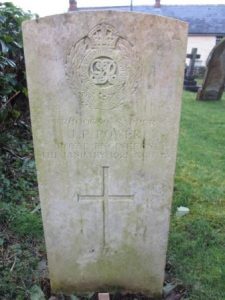
Harry Dallow Price, Private, 441054, Canadian Infantry. Harry was born on 23 May 1896, the son of Thomas William Price and Fanny Esther Price (nee Dallow), of Castle Terrace, Talgarth. His mother died in 1900, and his father remarried Isabella Louise Hopkins in 1905, before deciding to take the family out to Canada, where they took over a farm at Broadacres, Saskatoon. The two eldest children, daughters Ida and Frances, remained at Talgarth with their grandparents. Harry worked on his father’s farm at Saskatoon prior to enlisting into the Canadian Expeditionary Force on 28 April 1915. Upon arriving in Britain, he was posted to the 27th Battalion, Canadian Infantry, which was attached to the 6th Brigade, 2nd Canadian Division. Harry would have seen his first major action during the Battle of Mount Sorrel in June 1916, during a heroic action which saw the Canadians retake the hill following a large-scale German offensive. The Canadians moved to the Somme sector in September 1916, relieving the Australian Corps in front of Mouquet Farm and Courcelette. Harry was killed in action here on 15 September 1916. The 20-year-old has no known grave and is commemorated on the Vimy Memorial, France.
Percy Price, Private, 2211, Australian Infantry. Percy was born on 1 August 1894, the son of John Price and Eleanor Price (nee Thomas), of Talgarth. His father had died by 1901, by which time the family was residing at 14, Bryn Terrace, Ystradfodwg. His mother remarried to William Henry Saunders, before the entire family emigrated to Australia, embarking aboard the SS Omrah on 19 February 1909, and upon their arrival made their home at Penong, South Australia. Percy worked as a farmer prior to enlisting at Keswick into the 10th Battalion, Australian Infantry on 2 March 1915, and joined the 6th reinforcement draft for the battalion, which embarked from Adelaide for Egypt aboard HMAT Borda on 23 June 1915. Upon arriving at Alexandria, the men were transferred aboard HMT Berrime and on 4 August 1915 disembarked at Anzac Cove, Gallipoli. Percy’s battalion was preparing to take part in a forthcoming offensive, which was intended to draw Turkish attention away from further Allied Landings at Helles. On 6 August 1915, whilst preparing for the attack, and just two days after arriving at the front, Percy was killed when the Turks launched an intensive artillery barrage upon their positions at Leane’s Trench. The 20-year-old is buried in Lone Pine Cemetery, Anzac, Gallipoli. Percy is not commemorated locally.
Thomas Price, Private, 11744, South Wales Borderers. Thomas was born in 1879, the son of James and Eliza Price, of Penycae, Talgarth. He had moved to Glyntawe, near Abercrave as a young man to find work as a labourer, and married Joan Williams at St. Callwen’s Church on 4 November 1899. By 1911 the couple were living at Godrewern, Penycae with their two children, where Thomas was working as a coal hewer. Sadly, his wife Joan died the following year, so when Thomas enlisted into the South Wales Borderers at Brecon in August 1914, the two children went to live with their grandparents at Llanddeusant, Carmarthenshire. He was drafted to France on 2 November 1914 and joined the 1st Battalion, South Wales Borderers, which was in Flanders attached to 3 Brigade, 1st Division. The Division had suffered heavy casualties during the opening months of the war, taking part in the Battle of Mons and the subsequent retreat to the Marne, and then helped stop the Germans at the Battles of the Marne and Aisne, before the BEF moved to Ypres. The Division had then played a vital role in stopping the Germans capturing the important city, during the First Battle of Ypres, before wintering in Flanders, in the Neuve Chapelle sector. The 1st Division took part in its first major action of 1915 here on 9 May 1915, during the Battle of Aubers Ridge, when it attacked alongside the Meerut Division. The attack by 3 Brigade was held up by a flooded ditch, which the men forded, before being hit by heavy machine-gun fire, and a large number of casualties were suffered before the survivors withdrew. Thomas was wounded during the attack and was evacuated through the chain of Advanced Dressing Station and Field Ambulance to hospital at Bethune, where he died of his wounds two days later, on 11 May 1915. The 36-year-old was buried in Bethune Town Cemetery, France. Thomas is not commemorated on the Talgarth war memorial.
Rhys Thomas Prytherch, Private, 70532, The King’s (Liverpool Regiment). Rhys was born in 1883, the son of William Prytherch and Elizabeth Prytherch (nee Williams), of Lower Genffordd Farm, Talgarth. He was educated at Brecon County School and at Carmarthen Training College before training as a minister, graduating BA with Honours from the University of Wales, Cardiff, in 1903. He became a well-respected Methodist Minister at Swansea, then Hay, and was often to be seen taking services in the Market Square in Talgarth. He tried to enlist into the infantry soon after the outbreak of war but was rejected several times as unfit, due to a deformity in his leg which he had suffered from as a result of an accident while a young boy, but in 1917 he was finally accepted into the Labour Corps, joining the 13th Labour Company, King’s Liverpool Regiment. He became ill and died of meningitis in hospital at St. Omer on 23 March 1917, just ten days after arriving on the Western Front. The 34-year-old is buried in Longuenesse (St Omer) Souvenir Cemetery, France. Rhys is commemorated on war memorials at Swansea, Hay and at Trinity College, Carmarthen.
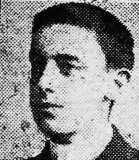
Arthur George Reed, Lance Corporal, 14577, Grenadier Guards. Arthur was born in 1894, the son of George Reed and Sarah Eliza Reed (nee Legg), of Elms Farm, Nettleton, near Chippenham. He married Doris Amelia Pewtner, a nurse, on 15 March 1915 and the couple already had a son, Frederick, born the previous month. Arthur had been a police officer at Abergavenny before leaving the force to work as an attendant at the Brecon and Radnor Asylum, Talgarth. A former soldier, he re-enlisted at the outbreak of war and was posted to the 2nd Battalion, Grenadier Guards, together with his brother Walter. The battalion was at Chelsea Barracks, attached to the 4th (Guards) Brigade, 2nd Division and on 15 August 1914 landed at Le Havre. The battalion then moved with the division to the Belgian frontier town of Mons, taking part in the Battle of Mons on 23 August 1914 and in the subsequent withdrawal to the Marne, where the German drive on Paris was halted. Arthur joined the battalion among a draft of reinforcements on 12 September, in time to take part in the Battle of the Aisne, the action which saw the formation of the Western Front, as the Germans were forced to entrench along the Chemin-des-Dames Ridge. On 13 October the division was relieved by the French and began to move northwards with the remainder of the BEF into Flanders. The Division had then played a vital role in stopping the Germans capturing the important city, during the First Battle of Ypres, before wintering in Flanders. Arthur was wounded in the head at some time after this, and upon recovering from his wounds was drafted out to France, joining the 3rd Battalion, Grenadier Guards, which was attached to the 2nd Guards Brigade, Guards Division. The Division saw its first major action during the Battle of Loos, which began on 25 September 1915, remaining in the area during the coming months, where they also fought in the subsequent Action of Hohenzollern Redoubt. In July 1916 the Division moved to the Somme, where it fought at the Battle of Flers-Courcelette, and then at the Battle of Morval, capturing Lesboeufs Village. The division remained here for the winter, and in March 1917 took part in the advance caused by the German Retreat to the Hindenburg Line. Later that year it moved north to Ypres and fought at the Battle of the Pilckem Ridge, the opening phase of the Passchendaele offensive. Arthur was killed in action at Pilckem Ridge on 31 July 1917. The 23-year-old is buried in Artillery Wood Cemetery, Belgium. His nephew, Arthur Reed, was killed in Italy in 1944.
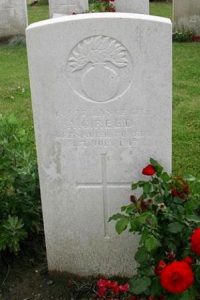
Reginald Charles Roberts, Private, 267529, Monmouthshire Regiment. Reginald was born at Talgarth in 1896, the son of David Roberts and Annie Roberts (nee Watkins), of High Street, Talgarth. His mother died in 1902 and in 1905 his father remarried to Elizabeth Agnes Davies. Reginald had left home by 1911 and was lodging at Pontarddulais, where he worked as a cowman. By the time war broke out he was working as a collier at the Abercynon Colliery. Reginald enlisted into the 2/1st Brecknockshire Battalion, South Wales Borderers at Talgarth on 4 August 1914. The battalion left Brecon for Dale, in Pembrokeshire in April 1915 to join the Milford Haven garrison, then at the end of 1915 moved to Bedford to join the 68th (2nd Welsh) Division. On 30 July 1916 Reginald was drafted to France and transferred to the 2nd Battalion, Monmouthshire Regiment, which was the Divisional Pioneer Battalion to the 29th Division. The Division had suffered terrible casualties at Beaumont Hamel, during its assault on Y-Ravine on 1 July 1916 and, although severely depleted, the Division remained in the line here over the coming weeks, in trying conditions. On 27 July the Division entrained for Flanders, detraining at Proven before relieving the 6th Division at Ypres. The Division held the line here over the coming weeks as it rebuilt its strength and the 2nd Monmouth’s worked hard on improving trenches and digging new communications trenches. The battalion then worked on the Menin Road, erecting elephant shelters, then on 4 October the Division was relieved and entrained south for the Somme once more, moving to Trônes Wood, before joining the latter stages of the Somme offensive. The Division wintered on the Somme, with the 2nd Monmouth’s working on road repairs. In the Spring of 1917, the division fought at the Battle of the Scarpe, which was part of the Arras Offensive, and then moved further north to Ypres, taking part in almost the entire Passchendaele offensive, before being relieved and moving to Cambrai. Here the division fought at the Battle of Cambrai in November and December 1917 before moving back to Flanders early in 1918. The German Spring Offensive hit the British on the Somme on 21 March 1918, and hit in Flanders just weeks later, on 9 April. The 29th Division was caught up in desperate fighting over the coming weeks until the German advance was stopped, suffering severe casualties. The division then settled down into routine trench warfare over the coming months, and the 2nd Monmouth’s again began work on road and trench repairs. Reginald was killed in action on 22 May 1918, during a routine day of work. The 22-year-old is buried in La Kreule Military Cemetery, Hazebrouck, France. His brother, William, had been killed in Mesopotamia just two months previously.
William Arthur Roberts, Private, 27809, South Wales Borderers. William was born at Usk in 1892, the son of David Roberts and Annie Roberts (nee Watkins). Soon after his birth the family moved to High Street, Talgarth. His mother died in 1902 and in 1905 his father remarried to Elizabeth Agnes Davies, before the family moved to Swan terrace. William enlisted into the 2/1st Brecknockshire Battalion, South Wales Borderers at Talgarth on 4 August 1914. The battalion left Brecon for Dale, in Pembrokeshire in April 1915 to join the Milford Haven garrison. William was drafted to Aden to join the 1/1st Brecknocks, and disembarked there on 3 July 1915, on the same day the battalion was suffering during a march through the desert which saw thirteen men die of heatstroke. In August 1915 the battalion moved to India on garrison duties. William then volunteered for front-line service in Mesopotamia, transferring initially to the 6th Battalion, Devonshire Regiment, but upon reaching the front, was posted to the 4th Battalion, South Wales Borderers. The battalion was attached to 40 Brigade, 13th (Western) Division, and had moved to Mesopotamia in March 1916 following service in Gallipoli and Egypt, to join the force being built up to attempt to relieve General Townshend’s besieged force in Kut. Following the surrender of Townshend, the Allies continued to build up forces in the country before beginning the arduous campaign to drive the Turkish occupiers out of the country. William was posted as missing during heavy fighting on 30 April 1917 and was later found to have been taken prisoner by the Turks. He died in captivity at Nissibin, in Turkey, on 25 March 1918 and was buried there. The 26-year-old is commemorated on a special ‘Kipling’ memorial headstone in Baghdad (North Gate) War Cemetery, Iraq.
William Robinson, Sapper, 200861, Royal Engineers. William was born in 1885, the son of William Robinson and Margaret Robinson (nee Thomas). His father died three years later, so his mother moved back in with her parents at Blainfinant, Talgarth, with William and his two siblings. William left home as a young man to work as a farm labourer. He married Mary Hannah Parry, of Railway Crossing, Talgarth on 28 February 1912, and the couple moved to Penrhiwceiber, where William had gained work as a railway platelayer. He enlisted into the Royal Engineers at Cefn-Coed on 11 December 1915 and was initially placed on the army reserve. William was mobilised on 21 September 1916 and on 9 October embarked at Devonport aboard the SS Huntsgreen for Basra. Upon disembarking on 2 December, William was posted to the Inland Water Transport at Basra Dockyard. He served for over eight months in Mesopotamia before taking ill and was invalided to the 33rd British General Hospital at Basra. From there he was invalided to India, arriving there on 6 September 1917 and taken to hospital at Trimulgherry. On the morning of 13 October 1917, William’s dead body was found lying on the floor outside one of the hospital barracks, dressed only in a shirt and one sock. A subsequent court of enquiry found that William must have tripped whilst paying a visit to the urinal bucket on the balcony on the first floor, and fallen over the railings, fracturing his skull and dying of accidental injuries. The 33-year-old is buried in Bolarum Cavalry Barracks Cemetery, India.
Christopher James Saunders, Private, 29782, South Wales Borderers. Christopher was born at Talgarth in 1891, the son of William Saunders and Elizabeth Saunders (nee Sweet), of Church Street. Following the death of his father in 1908, the family moved to Tywaun, Pwll, near Llanelli and Christopher worked as a postman. Christopher enlisted at Llanelli into the South Wales Borderers during the winter of 1915 and was drafted to Egypt to join the 4th Battalion, South Wales Borderers, which was attached to 40 Brigade, 13th (Western) Division. By 8 January 1916, the Division had been evacuated from Helles, and by 31 January was concentrated at Port Said, where it held forward posts in the Suez Canal defences. On 12 February 1916 the Division began to move to Mesopotamia, to strengthen the force being assembled for the relief of the besieged garrison at Kut al Amara, but the relief failed, and Kut fell to the Turks. The Division then took part in the advance through Mesopotamia, which was to successfully liberate the country from centuries of Ottoman rule. By 28 May 1918, Divisional HQ had moved to Dawalib, and it remained here until the end of the war. Many working parties were supplied for work on maintaining roads. On 1 July 1918 the Division received orders to detach 39 Brigade for the North Persia Force. Christopher was taken ill and died in Mesopotamia on 3 July 1918. The 27-year-old is buried at Baghdad (North Gate) War Cemetery, Iraq. Christopher is not commemorated on the Talgarth war memorial.
Frank Ronald Skan, Private, 200697, South Wales Borderers. Frank was born in Worcester on 9 September 1896, the son of Richard Shirley Skan, a tobacco dealer, and Mary Olive Skan (nee Jones). Frank had taken part in a voyage with the Mercantile Marine from Britain to America and back but left the service and moved to Talgarth to run a male hairdresser’s shop. Following the outbreak of war he enlisted at Brecon into the Brecknockshire Battalion, South Wales Borderers. The battalion was attached to the Welsh Division and moved to Pembroke Dock upon mobilisation. It was then withdrawn from the Division and on 29 October 1914 sailed from Southampton for Bombay, where the battalion transhipped and sailed for Aden, arriving on 16 December 1914. The climate in Aden was fearsome, with scorching heat during the day, and with little to do, the men spent much of their free time playing football. By June 1915 the Turks had become overconfident due to the lack of any incursions by the British into Yemen and moved forward to reoccupy fortifications at Sheikh Saad. They then began to shell the island of Perim, so the Allied troops in Aden were mobilised into the Aden Movable Company and ordered to prepare to join with local troops. 400 men of the Brecknocks were allocated to the column, the remainder stayed in Aden. A small artillery column was built up to join it and on 3 July the force moved out to Sheikh Othman. Many men collapsed on the march, which was carried out during the full heat of the day, but by 7.30 pm the column had completed its six-mile advance. Frank was among thirteen men who died of heatstroke during the following day, 4 July 1915, during an even longer march. The 18-year-old was originally posted as missing but had fallen out during the march. He has no known grave and is commemorated on the Heliopolis (Aden) Memorial, Egypt.
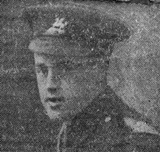
Joseph Herbert Smith, Corporal, 813, South Wales Borderers. Joseph was born in 1879, the son of William Smith and Emily Smith (nee Hardman), of 63, Coldbath Road, King’s Heath, Birmingham. He came to Talgarth in 1907 after gaining work as a gardener at the Brecon and Radnor Asylum. Joseph married Mary Ann Riley, of Rushall, Staffordshire in August 1908 and the couple settled at Church Cottage, Talgarth. Sadly, Mary died in 1910, so her mother and one brother came to live with Joseph. Joseph was already serving with the Brecknockshire Battalion, South Wales Borderers when war broke out. The battalion was attached to the Welsh Division and moved to Pembroke Dock upon mobilisation. It was then withdrawn from the Division and on 29 October 1914 sailed from Southampton for Bombay, where the battalion transhipped and sailed for Aden, arriving on 16 December 1914. The climate in Aden was fearsome, with scorching heat during the day, and with little to do, the men spent much of their free time playing football. By June 1915 the Turks had become overconfident due to the lack of any incursions by the British into Yemen and moved forward to reoccupy fortifications at Sheikh Saad. They then began to shell the island of Perim, so the Allied troops in Aden were mobilised into the Aden Movable Company and ordered to prepare to join with local troops. 400 men of the Brecknocks were allocated to the column, the remainder stayed in Aden. A small artillery column was built up to join it and on 3 July the force moved out to Sheikh Othman. Many men collapsed on the march, which was carried out during the full heat of the day, but by 7.30 pm the column had completed its six-mile advance. Joseph was among thirteen men who died of heatstroke during the following day, 4 July 1915, during an even longer march. The 36-year-old has no known grave and is commemorated on the Heliopolis (Aden) Memorial, Egypt.
John Thomas, Private, 2663, Welsh Regiment. John was born in 1872, the son of John Thomas and Gwen Thomas (nee Hopkins), of Llanspyddid. The family lived at Builth, then at Merthyr Tydfil and Aberdare over the coming years, before moving to Hoellas Cottage, Talgarth prior to 1911. John worked as a colliery horse drive prior to enlisting into the Welsh Regiment at Cardiff soon after the outbreak of war and was most likely an army reservist. He was drafted to France, disembarking on 29 November 1914, before joining the 2nd Battalion, Welsh Regiment. The battalion was in Flanders, holding positions near Neuve-Chapelle, and was attached to 3 Brigade, 1st Division. The Division had suffered heavy casualties during the opening months of the war, taking part in the Battle of Mons and the subsequent retreat to the Marne, and then helped stop the Germans at the Battles of the Marne and Aisne, before the BEF moved to Ypres. The Division had then played a vital role in stopping the Germans capturing the important city, during the First Battle of Ypres, before wintering in Flanders. The 1st Division took part in its first major action of 1915 here on 9 May 1915, during the Battle of Aubers Ridge, when it attacked alongside the Meerut Division. The attack of the 2nd Welsh was held up by a flooded ditch, which the men forded, before being hit by heavy machine-gun fire, and a large number of casualties were suffered before the survivors withdrew. The division then took part in heavy fighting during the Battle of Loos, which opened on 25 September 1915, and the subsequent action at the Hohenzollern redoubt. John spent a short period attached to the 26th Field Company, Royal Engineers before re-joining the 2nd Welsh. He was wounded at Loos soon afterwards and taken prisoner by the Germans, before being evacuated to the French No 11 Field Hospital at Carvin, where he died of his wounds on 24 November 1915. The 43-year-old was originally buried in Carvin Communal Cemetery, in a plot of German war graves, but in February 1921, his grave was exhumed, and he was re-interred in Cabaret-Rouge British Cemetery, Souchez, France.
John Watkins, Private, 15944, Royal Welsh Fusiliers. John was born in 1888, the son of Walter Watkins and Margaret Watkins (nee Powell), of Llanfihangel-Tal-y-Llyn. He was raised by his grandparents at Bank terrace, Talgarth, before becoming a shepherd at the Brecon and Radnor Asylum, by which time his parents had moved to Pendriff House, Talgarth. John then began work as a mason prior to the war. He was already served with the Brecknockshire Battalion, South Wales Borderers prior to the war, having enlisted at Talgarth on 20 April 1908 and had taken part in the annual TA summer camps at Brecon, Porthcawl and Aberystwyth over the coming years until being discharged on 1 April 1911. John re-enlisted into the army soon after the outbreak of war, joining the 9th Battalion, Royal Welsh Fusiliers. The battalion had formed at Wrexham in September 1914, before moving to Tidworth to join 58 Brigade, 19th (Western) Division. On 19 July 1915 Evan landed in France with the battalion, and the entire 19th Division then moved to the Nursery Sector at Calonne for trench initiation alongside the Dehra Dun Brigade. The infantry battalions of the division then began carrying out the usual routines of rotating in the trenches: four days in the front line; four in support; and four in reserve, interspersed with training regimes and carrying out working parties and trench raids. Just south, the British launched a great offensive around the town of Loos on 25 September 1915, and the 19th Division was ordered to attack from its positions at the same time, to attempt to draw enemy attention away from the main battle area. The attacking battalions of the 19th Division were in place by 04.00, and then at 05.50 the men climbed out of their trenches to launch their assault, behind a gas and smoke screen. The assault was a disaster, and heavy casualties were suffered by the 19th Division for no gain. John survived the carnage that day, then following the battle, the 19th Division settled down for the winter in the same sector, carrying out the usual routines of static trench warfare over the coming months. John was wounded by a sniper whilst working on improving the trench parapet on 25 March 1916, just hours after the 9th RWF had relieved the 20th Battalion, Lancashire Fusiliers in the front line to begin a routine tour in the trenches. He was evacuated to hospital at nearby Merville, where he died of his wounds on the following day, 26 March 1916. The 28-year-old was buried in Merville Communal Cemetery, France.
John Henry Watkins, Private, 88870, Royal Welsh Fusiliers. John was born in 1885, the son of John Watkins and Jane Watkins (nee Davies), of West Street, Builth Wells. He married Ellen Full, a laundress at Talgarth Asylum, at Talgarth on 5 July 1913 and the couple set up home at 2, Regent Street, Talgarth. John worked as a plumber prior to the war. He enlisted into the Royal Welsh Fusiliers during the spring of 1918 and was drafted to France that summer, joining the 9th Battalion, Royal Welsh Fusiliers, which was attached to 58 Brigade, 19th (Western) Division. John joined the battalion in time to take part in the great 100 days offensive which won the war. He was wounded just prior to the Armistice, and was evacuated to the hospital at Rouen, where he died of his wounds on 26 November 1918. The 33-year-old is buried in St. Sever Cemetery Extension, Rouen, France.
Edgar Josiah Williams, Lance Corporal, 2066, Royal Gloucestershire Hussars. Edgar was born in 1894, the son of Rees Williams and Jane Williams (nee Davies), of New Inn, Talgarth. He worked as a butcher prior to the war, and had enlisted into the Royal Gloucestershire Hussars, a Yeomanry unit, in 1913. The battalion mobilised at Gloucester on 4 August 1914, joining the 1st South Midland Mounted Brigade and moved with the brigade to Bury St. Edmunds to join the 1st Mounted Division. At the end of August, the brigade moved to Newbury to join the 2nd Mounted Division, then moved to the Kings Lynn area in November 1914. The 2nd Mounted Division embarked for Egypt in April 1915 and remained there until being posted to Gallipoli in August 1915, to take part in the final push of the campaign. The division was evacuated in December 1915 and returned to Egypt, where it was broken up in January 1916 and the 1st South Midland Mounted Brigade became the 5th Mounted Brigade, an independent unit, attached to XV Corps in the Suez Canal area. By late March the Royal Gloucestershire Hussars began patrolling the Sinai, before assembling at Romani, some 21 miles east of the canal. Early on 23 April, A Squadron of the battalion was stationed at Qatia when it came under attack by a strong Turkish force, which had already defeated two squadrons of the Queen’s Own Worcestershire Hussars and a party of Royal Engineers. The Gloucester’s suffered heavy casualties, leading to some unjust criticism at the time. A Squadron was then rebuilt, whilst the other Squadrons maintained offensive patrolling in the Sinai. On 4 August, D Squadron took part in the Battle of Romani, when it held onto its vital position for three hours, under intense fire. Its next major action was on 9 January 1917, during the Battle of Rafa, during which it fought dismounted. Edgar was killed in action during the battle that day. The 22-year-old is buried in Kantara War Memorial Cemetery, Egypt.
Gwilym Thomas Williams, MM, Lance Corporal, 7131, Welsh Regiment. Gwilym was born at Talgarth in 1883, the son of Morgan Williams and Mary Ann Williams. His father died in 1900, and his mother remarried to Reginald Price Powell. The family then moved to Mountain Ash. Gwilym then left home and enlisted into the Welsh Regiment at Aberdare on 21 February 1902, becoming a Bandsman with the 2nd Battalion, Welsh Regiment. In the summer of 1913, Gwilym married Lizzie Wilson, of 45, Palfrey Street, Fulham. The 2nd Welsh entrained for the south coast within days of war breaking out and on 13 August 1914 landed in France. The battalion was attached to 3 Brigade, 1st Division and entrained for the Belgian frontier, near the town of Mons. The Division then took part in the Battle of Mons on 23 August, following the German invasion of the low countries, and in the epic withdrawal from Mons to the River Marne, where the German drive on Paris was halted. The Germans then withdrew north and took up defensive positions north of the river Aisne, along the Chemin des Dames Ridge and the BEF advanced before launching a frontal attack upon the German positions. The battle ended in a stalemate, and the BEF was relieved before beginning to move to Flanders on 17 October, before advancing from Poperinghe past endless numbers of refugees and took up positions guarding the strategically vital city of Ypres, the 1st Division taking up positions near Langemarck by 21 October. Later that day the division was attacked by hordes of Germans, mainly young student-soldiers, who were mown down by the highly trained British soldiers. The Germans maintained their attacks over the coming days but were held at bay, sustaining terrible losses, and the line here stabilised, so by 27 October the 1st Division moved to positions near Zandvoorde, guarding the Menin Road. On 31 October 1914 the 1st Division faced its sternest test so far, when the Germans attacked its positions on the Menin Road, behind a fearsome artillery bombardment. The fighting saw 3 Brigade virtually annihilated, and after moving out of the line for a short spell to rebuild, the 1st Division moved to positions north-east of Bethune, near Richebourg for the winter. The 1st Division took part in its first major action of 1915 here on 9 May 1915, during the Battle of Aubers Ridge, when it attacked alongside the Meerut Division. The attack of the 2nd Welsh was held up by a flooded ditch, which the men forded, before being hit by heavy machine-gun fire, and a large number of casualties were suffered before the survivors withdrew. The Division then saw further heavy fighting during the Battle of Loos, which opened on 25 September 1915, and during the ensuing action at the Hohenzollern redoubt. During July 1916 the Division moved south, to join the great Somme offensive, and the 2nd Welsh reached Albert by 11 July, taking up billets in the town. On the morning of 15 July, the 2nd Welsh received orders to proceed via the recently captured Mametz Wood to the new front line, facing Bazentin Ridge, and took over positions near Bazentin-le-Petit Wood. On the following morning the battalion took part in its first assault on the Somme, but came under intense machine-gun fire, forcing the battalion to withdraw. On 19 July, after a torrid spell in the line, the 2nd Welsh was relieved and moved into reserve for a rest, then a week later moved back into the front-line to begin another horrific spell in the trenches. The 2nd Welsh continued to fight hard over the coming weeks, with its spells in action tempered by brief rest periods. Gwilym was killed in action at High Wood on 21 August 1916, while the 2nd Welsh were digging a sap trench. The 33-year-old is buried in Caterpillar Valley Cemetery, Longueval, France. Gwilym is not commemorated on the Talgarth war memorial. He had been awarded the Military Medal for his bravery during the early stages of the Somme battles.
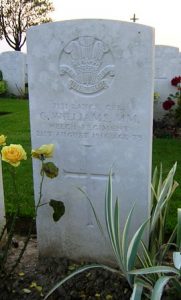
Benjamin Reuben Williams, Private, 267557, Monmouthshire Regiment. Benjamin, known as Reuben, was born in 1895, the son of Thomas Williams and Annie Williams (nee Watkins), of Baileau Bach Farm, Talgarth. He left home to work as a cowman for Evan Williams at Pentregwyn, Llanfihangel Nant Bran, but was working for David Evans at Great Porthamel prior to the war. Reuben had enlisted into the Brecknockshire Battalion, South Wales Borderers at Talgarth on 11 May 1914 and was in the annual TA summer camp when war was declared. Upon mobilisation, he was posted to the 2/1st Brecknockshire Battalion, South Wales Borderers, which formed at Brecon September 1914. The battalion left Brecon for Dale, in Pembrokeshire in April 1915 to join the Milford Haven garrison, then at the end of 1915 moved to Bedford to join the 68th (2nd Welsh) Division. Reuben was drafted to France on 30 July 1916 and was posted from the Infantry Base Depot to the 2nd Battalion, Monmouthshire Regiment, which was the Divisional Pioneer Battalion to the 29th Division. The Division had suffered terrible casualties at Beaumont Hamel, during its assault on Y-Ravine on 1 July 1916 and, although severely depleted, the Division remained in the line here over the coming weeks, in trying conditions. On 27 July the Division entrained for Flanders, detraining at Proven before relieving the 6th Division at Ypres. The Division held the line here over the coming weeks as it rebuilt its strength and the 2nd Monmouth’s worked hard on improving trenches and digging new communications trenches. The battalion then worked on the Menin Road, erecting elephant shelters, then on 4 October the Division was relieved and entrained south for the Somme once more, moving to Trônes Wood, before joining the latter stages of the Somme offensive. The Division wintered on the Somme, with the 2nd Monmouth’s working on road repairs. In the Spring of 1917, the division fought at the Battle of the Scarpe, which was part of the Arras Offensive. The division remained in the Monchy sector after the closure of the Battle of Arras, and was relieved at the beginning of June, refitting before moving into the Ypres Salient by 19 June. The 2nd Monmouth’s moved into a tented camp at Woesten before beginning work on roads and trench railways around Elverdinghe, in preparation for the forthcoming Passchendaele offensive. Reuben was at work on the Yser Canal bank when he was badly wounded on 28 June, when the trenches were hit by German artillery fire. He was evacuated to the casualty clearing station at Remi Sidings, where he died of his wounds the following day, 29 June 1917. The 22-year-old is buried in Lijssenthoek Military Cemetery, Belgium.
William Francis David Williams, Private, 49820, Royal Fusiliers. William was born in 1894, the son of Evan Williams and Mary Williams (nee Price), of High Street, Talgarth. Upon leaving school, he worked for the United County Bank, at Abergavenny. He enlisted into the 26th (Banker’s) Battalion, Royal Fusiliers soon after the outbreak of war. William came home to Talgarth on leave in August 1916, before being drafted out to France in October 1916, joining the 22nd (Kensington) Battalion, Royal Fusiliers. The battalion was on the Somme, attached to 99 Brigade, 2nd Division, which was holding the Redan Ridge sector when William arrived. The Kensington’s were in billets in Bertrancourt resting when William joined their ranks, among a draft of 25 men. On 13 November the battalion moved back into the trenches, giving William his first taste of the terrible conditions, the division was enduring on the battle-scarred ridge, and moved across No Man’s Land to set up a defensive flank at the Quadrilateral position. The division then took part in the final stages of the Somme offensive on the Ancre, before settling down for the winter there and its infantry battalions began the regular routines of rotating for duty in the trenches. On 16 February 1917 the Kensington’s moved into positions at Miraumont, to take part in a local assault upon the Germans, in conjunction with the 1st KRRC. The assault took place on the morning of 18 February 1917, but heavy casualties were suffered, mainly due to the state of the muddy ground slowing down the attack. William was mortally wounded that day and was evacuated to the 4th Casualty Clearing Station, where he died of his wounds on the following day, 19 February 1917. The 22-year-old was buried in Varennes Military Cemetery, France.
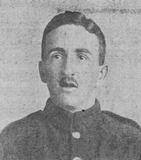
World War Two, 1939-1945
Harold Frank Evans, Private, 5573192, Wiltshire Regiment. Harold was born on 17 November 1919, the son of Frank Evans and Miriam Evans (nee Traylor), of Park House, Talgarth. The family had moved to Weston Super Mare prior to the war, and Harold married Margaret Ruby Robbins there in 1939. He enlisted into the army and was posted to the 4th Battalion, Wiltshire Regiment. The battalion was a Territorial Army unit and was attached to the 129th Infantry Brigade, 43rd (Wessex) Division. The division spent most of the war on home service, before beginning training in earnest for the invasion of Europe. The division landed in Normandy two weeks after D-Day and concentrated around Bayeux. The division then took part in the bloody fighting at the Battle of Odom, the fight for Hill 112 (Operation Jupiter), and the capture of Mont Picon, before forcing a crossing of the river Seine and beginning the drive through Northern France into Belgium and Holland. The division was part of the force that tried to reach the airborne troops of the US 82nd and 101st Airborne Divisions, as well as the British 1st Airborne Division fighting at Arnhem, during Operation Market Garden, before taking part in the Geilenkirchen Offensive in October 1944. The division then took part in Operation Veritable the following year, alongside the Canadians. Harold was killed near the Reichswald on 15 February 1945. The 26-year-old is buried in Reichswald Forest War Cemetery, Germany. Harold is not commemorated on the Talgarth war memorial.
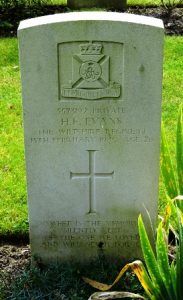
John Leslie Games, Carpenter, Merchant Navy. John was born at Cardiff on 5 February 1914, the son of Alfred Games and Mary Ann Games (nee Price). Following the death of his mother in 1916, the family moved back to his fathers native Talgarth, to Park View, Regent Street, Talgarth. John trained as a carpenter and joiner with his father prior to the war. He then enlisted into the Merchant Navy, as a Carpenter, and was posted aboard the Newcastle-on-Tyne registered steamship, SS Holystone. In February 1941, Holystone left Hull to join Convoy OB-284 at Oban, bound for Halifax, Nova Scotia. She was straggling behind the main convoy during the early hours of 15 February 1941 when she was spotted by the German submarine U-123, which fired a spread of torpedoes at the helpless ship. One torpedo struck her amidships and Holystone exploded and sank, with the loss of all 37 of her crew. John was 27 years old when he was killed that day. He has no known grave but the sea, so is commemorated on the Tower Hill Memorial, London.
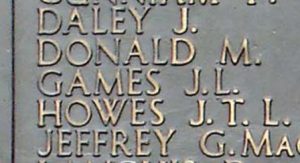
Bohumil Makovsky, Vojin, F.3776, Czechoslovakian Army. Bohumil was born in Czechoslovakia on 22 October 1894. He was serving with the Czechoslovakian Army when their country was invaded by the Germans on 15 March 1939. Following the fall of his country, he fled to Britain with other members of the Czech forces and joined the newly formed 1st Smisena Brigade, an armoured unit. Bohumil died at Talgarth on 27 January 1943. The 48-year-old was buried in St. Gwendolen’s Churchyard, Talgarth. He is not commemorated on the Talgarth war memorial.
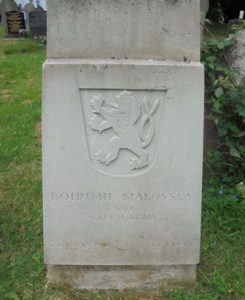
Hubert Arthur Moore, Private, 3908205, Army Catering Corps. Hubert was born on 7 May 1912, the son of Sarah Ann Moore, of Talgarth. His mother married Arthur Samuel Bedford on 12 December 1914, but sadly died two years later, making Hubert an orphan. Hubert married Agnes Bevan in 1940. He enlisted into the Army Catering Corps soon after the outbreak of war and was attached to the 3rd Battalion, Monmouthshire Regiment. The battalion, a Territorial Army unit, mobilised for war as part of the 159th Infantry Brigade, 53rd (Welsh) Division and moved to Northern Ireland to begin garrison duties. The Division then moved to Pembroke Dock, before moving again to the south of England, where it trained in readiness for the D-Day Landings. In the summer of 1942, the 3rd Monmouth’s transferred to the 11th Armoured Division and began training as a mechanised unit, equipped with Valentine and Crusader tanks. Most of the 11th Armoured Division landed on Juno Beach on 13 June 1944 and saw its first major action during Operation Epsom on 26 June, where it assisted the 15th (Scottish) Division alongside the 159th Brigade, which had been attached to it from the 53rd (Welsh) Division. Hubert was killed in action during the fighting, on 30 June 1944.The 32-year-old is buried in Banneville-La-Campagne War Cemetery, France.
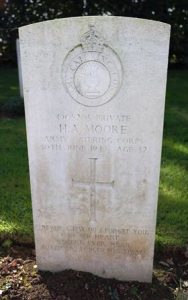
Leonard Charles Pugh, Private, 4079559, South Wales Borderers. Leonard was born in 1906, the son of James Pugh and Ada Ann Pugh (nee Silvester), of Craigau Cottages, Talgarth. He married Winifred Mabel Carey at Talgarth in 1934 and the couple set up home at 1, Craigau Cottage. Leonard was probably a regular soldier, as he was absent from home during the 1939 Census. He served with the 1st Battalion, South Wales Borderers. The Battalion was attached to the 10th Indian Infantry Division and was sent to Iraq to quell a German-inspired uprising in November 1941. The battalion then saw further service in Iran before being sent to North Africa, to Tobruk, taking over defensive positions at Bel Hamed. The battalion was virtually annihilated when Tobruk became besieged in June 1942, and the few survivors endured a marathon trek across the Libyan Desert to safety. The battalion was then disbanded, and the survivors were posted to the 1st Battalion, King’s Own Royal Regiment (Lancaster). Leonard must have been among this group of survivors, as he was killed soon afterwards, on 3 September 1942. The 36-year-old is buried in Tripoli War Cemetery, Libya.
Thomas Noel Pugh, Sergeant, 1376031, Royal Air Force Volunteer Reserve. Thomas was born in 1918, the son of Charles Pugh and Catherine Pugh (nee Thomas), of Castle View, Talgarth. He married Olive Cole in Surrey in 1939. Thomas had enlisted into the Royal Air Force Volunteer Reserve soon after the outbreak of war and after completing his training as a Wireless Operator/ Air Gunner was posted to 419 (R.C.A.F.) Squadron, Royal Air Force. The squadron was affiliated to the Royal Canadian Air Force and was a Bomber Command, based at RAF Mildenhall, in Suffolk. On 15 January 1942, Thomas took off from Mildenhall aboard a Vickers Wellington Ic, Serial Z1145, which joined a large force of bombers sent to hit targets in Hamburg, a vital centre for the production of U-Boats. The Wellington successfully carried out its mission before returning home, but unfortunately ran out of fuel and crashed into the sea off Spurn Head on the morning of 16 January 1942, with the loss of four of its six crewmen. Thomas was 22 years old when he was killed. He has no known grave, so is commemorated on the Runnymede Memorial, Surrey.
George Henry Tanswell, Serjeant, Home Guard. George was born on 1 March 1904, the son of George Henry Tanswell and Catherine Tanswell (nee Bentley), of Talgarth. He married Rhoda Elizabeth Lilwall at Talgarth on 5 April 1925 (Her father, Ambrose Lilwall, had died in 1918 of illness contracted during the Great War). George enlisted into the Home Guard soon after the outbreak of war and served with the 2nd Brecknockshire (Builth Wells) Battalion. Most of the men serving in the battalion were either over or underage for service in front-line units. George died at Talgarth on 18 January 1942. The 37-year-old was buried in St. Gwendolen’s Churchyard, Talgarth.
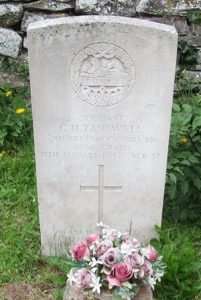
David Edwin Williams, Chief Engineer Officer, Merchant Navy. David was born in Talgarth on 27 July 1891, the son of Edwin Williams and Olivia Williams (nee Phillips). His father died in 1903 and his mother moved the family to Aberystwyth, where David was educated at Ardwyn School. The family then moved to Barry, where David began an engineering apprenticeship with the Mercantile Marine. Following the outbreak of the Great War, he enlisted into the Royal Flying Corps. He went back to sea after the war and by the outbreak of WW2 was serving aboard the Liverpool registered steamship SS Haig Rose. On 5 November 1940 Haig Rose steamed from Barry for Plymouth, but was never seen again, disappearing with all seven of her crew. David was 46 years old when his ship went missing, and he is commemorated alongside his fellow crew on the Tower Hill Memorial, London. David is not commemorated on the Talgarth war memorial.
